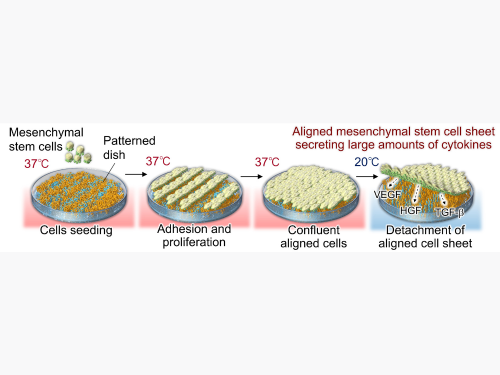A new way to grow stem cells may help them release more of the signaling proteins they use to repair tissue, potentially improving future treatments.
The illustration shows the fabrication of an aligned mesenchymal stem cell sheet (Courtesy of Kenichi Nagase/Hiroshima University)
Scientists have developed a technique that aligns stem cells into a single sheet, resulting in a marked increase in the secretion of signaling proteins which help repair tissue and regulate the immune system. The new approach, described in the journal Materials Today Bio, could improve stem cell-based treatments for conditions such as heart disease, liver damage, and autoimmune illnesses.
To grow the cells, researchers from Hiroshima University, Keio University and Tokyo Women’s Medical University in Japan and from the University of Utah used a specially designed culture surface that responds to temperature. The surface features alternating stripes that guide stem cells to grow in a parallel manner, similar to how cells are arranged in muscle or skin tissue. By controlling the way cells align during growth, the researchers were able to enhance their natural function.
Also Read: Cell sheet production efficiency greatly influenced by polymer brush lengths and densities
“Mesenchymal stem cell sheets are attracting attention as an effective regenerative medicine,” says study corresponding author Kenichi Nagase, professor at Hiroshima University’s Graduate School of Biomedical and Health Sciences. “Therefore, we thought that if we could improve the function of mesenchymal stem cell sheets, their therapeutic effect could be improved.”
Nagase explains that “the use of striped temperature-responsive culture dishes increases the amount of cytokines secreted from the sheets.” When the cells were grown on the patterned surface, the team observed a clear increase in important healing factors, like vascular endothelial growth factor, hepatocyte growth factor, and transforming growth factor-β.

An illustration showing the preparation of a patterned temperature-responsive dish (Courtesy of Kenichi Nagase/Hiroshima University)
Mesenchymal stem cells have been extensively studied for their potential to treat injuries or even chronic conditions due to their ability to support tissue regeneration. However, when delivered as individual cells, mesenchymal stem cells often disperse unpredictably in the body and fail to remain at the site of injury or disease.
Researchers have explored growing the cells into sheets which can be transplanted more directly to damaged tissue. These sheets preserve natural cell-to-cell contact and the extracellular matrix, a protein-rich structure that helps hold cells together. This gives the sheets greater durability and functionality than cells delivered in suspension.
The new technique was found not to interfere with the cells’ natural potential to turn into other useful cell types, but it did change how effectively they work together as the structure seems to enhance communication and cooperative function.
The striped surface was made using a simple modification of commercially available culture materials, avoiding the need for expensive nanofabrication methods. When the temperature is lowered, the entire sheet of aligned cells detaches gently, allowing it to be transplanted without damage.
By enhancing the function of mesenchymal stem cell sheets, the team hopes to make treatments more efficient and targeted. Nagase says the oriented mesenchymal stem cell sheets could be applied for regenerative medicine. The sheets could be especially useful for promoting blood vessel formation in heart disease, supporting liver repair, or modulating immune responses in autoimmune disorders, offering a promising step toward more effective and accessible cell-based therapies.
About the study
- Journal: Materials Today Bio
- Title: Functional aligned mesenchymal stem cell sheets fabricated using micropatterned thermo-responsive cell culture surfaces
- Authors: Kenichi Nagase, Hasumi Kuramochi, David W. Grainger & Hironobu Takahashi
- DOI: 10.1016/j.mtbio.2025.101657
Media Contact
Inquiries on the study
Kenichi Nagase
Professor, Graduate School of Biomedical and Health Sciences
E-mail: nagase * hiroshima-u.ac.jp
(Note: Please replace * with @)
Inquiries on the story
Hiroshima University Public Relations Office
E-mail: koho * office.hiroshima-u.ac.jp
(Note: Please replace * with @)

 Home
Home
















